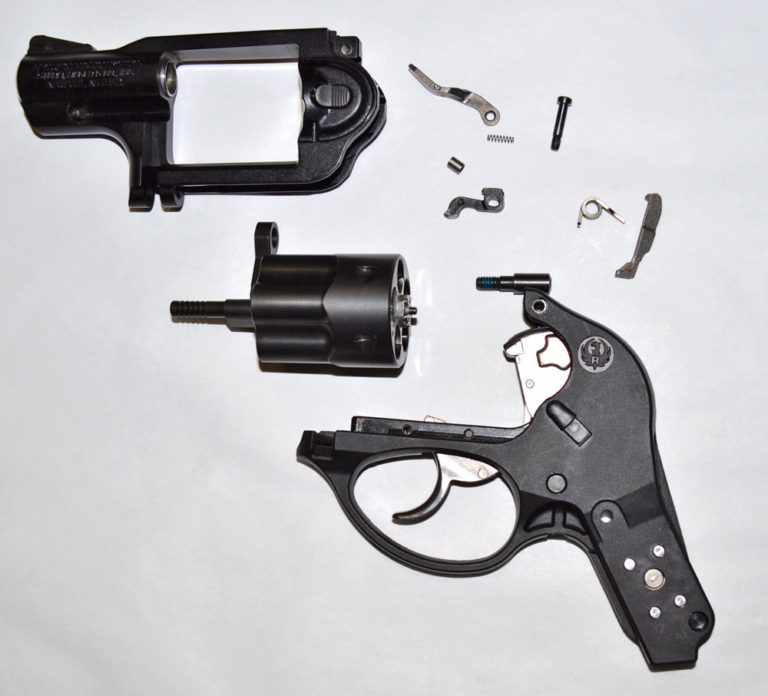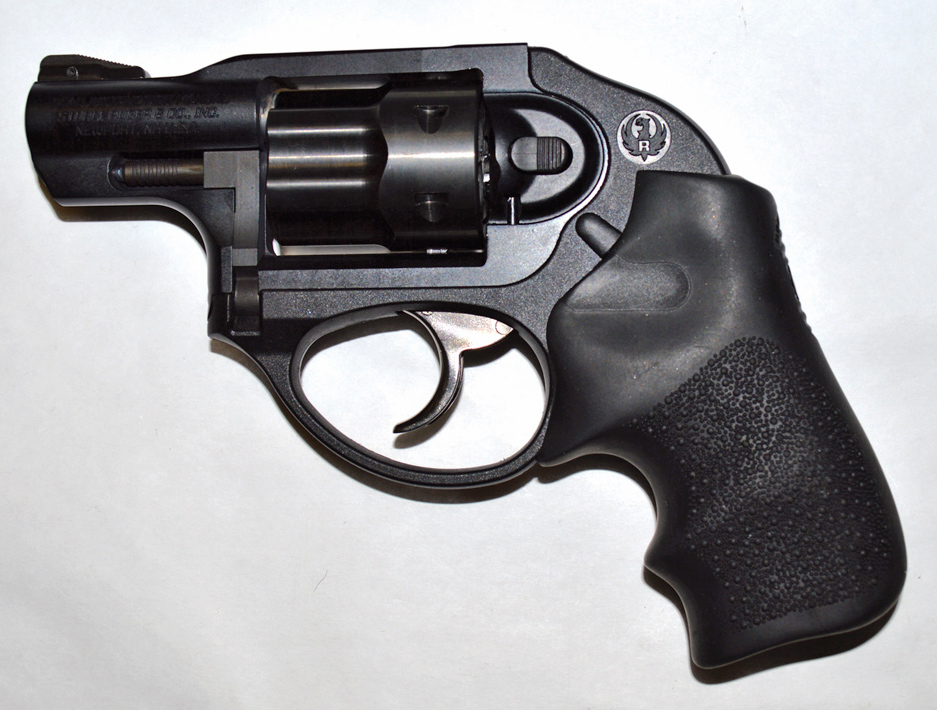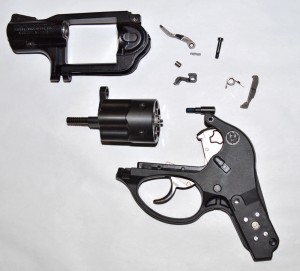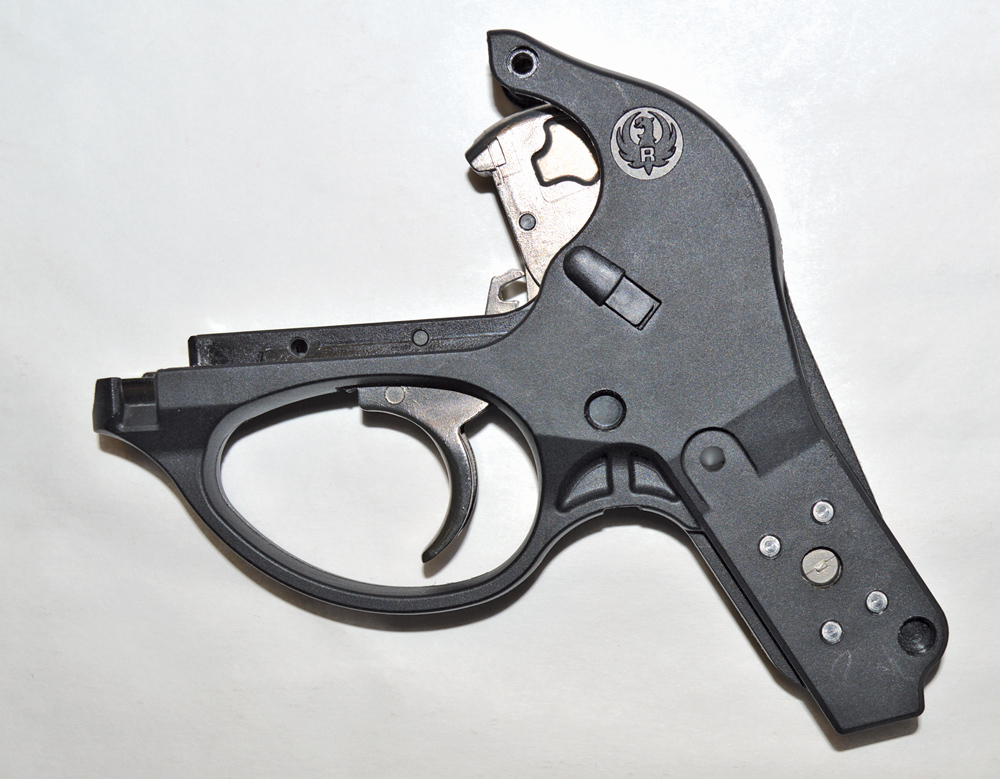

The Ruger LCR

The space-age LCR is Ruger’s latest revolver, one that’s a marvel in design and modern material. The letters LCR stands for “Lightweight Compact Revolver.”
Introduced in 2009, the polymer-framed (that’s plastic!) LCR is chambered in .38 Special +P, .357 Magnum, .22 LR, and .22 WMR.
It features a five-shot stainless steel cylinder in the two larger rounds, while the .22 LR is an eight-shot and the .22 WMR is a six-shot.
The stainless steel barrel is a short 1.875 inches, keeping with the compact theme, the LCR has fixed sights, and it’s available with rubber Hogue grips or Crimson Trace laser grips. The frame is finished in a matte black. The little LCR tips the scales at a whopping 13 ounces!
The LCR is unique in a number of ways. In a more conventional revolver design, the hammer and trigger assemblies are located in two separate housings (e.g. in single-action revolvers, a cylinder frame and a grip frame).

In the case of the LCR, the hammer and trigger—the “fire control center,” as Ruger calls it—are located in the same housing (the fire control housing), eliminating the increase to the tolerance stack common in conventional revolver configurations and their separate housings.
By locating the entire assembly in one housing, Ruger gets a rigid, repeatable fire control system that requires no fitting or gunsmithing to achieve a best-in-class trigger pull.

Next Step: Get your FREE Printable Target Pack
Enhance your shooting precision with our 62 MOA Targets, perfect for rifles and handguns. Crafted in collaboration with Storm Tactical for accuracy and versatility.
Subscribe to the Gun Digest email newsletter and get your downloadable target pack sent straight to your inbox. Stay updated with the latest firearms info in the industry.

![Best Concealed Carry Guns In 2025 [Field Tested] Wilson Combat EDC X9S 1](https://gundigest.com/wp-content/uploads/Wilson-Combat-EDC-X9S-1-324x160.jpg)


![Best 9mm Carbine: Affordable PCCs [Tested] Ruger Carbine Shooting](https://gundigest.com/wp-content/uploads/Ruger-Carbine-Shooting-100x70.jpg)
![Best AR-15: Top Options Available Today [Field Tested] Harrington and Richardson PSA XM177E2 feature](https://gundigest.com/wp-content/uploads/Harrington-and-Richardson-PSA-XM177E2-feature-100x70.jpg)

I bought mine in .357 so I could shoot both calibers, a no-brainer there. After a couple boxes (not all at once) of .357, I’ve switched to .38 only. After a box of .38, my hand will be pretty sore next day, but after just a few rounds of .357, I had to hold back the tears! Still, I likes it a lot and bought it in .22 and added a pink Hogue grip for my wife. The DAO always takes some getting used to. I carry it often.
Having not shot my LCR 357 as of yet, I cannot say it will not be an awakening of sorts. I will say that to this point in my handgun shooting adventures, these are the weapons that have poised the greatest challenges. Ruger LCP without a rubber sleeve or rubber grip, It’s a nasty little bugger, due to the thin profile & lightweight. Gave me a welt on my palm after 50 rounds. Still love it though, for what it is, it is an accurate and reliable piece; I do have the replacement Hogue grip now, no longer nasty, not even after 50 rounds. Bond Arms Snake Slayer IV with 3″ high velocity 410 shells. If it wasn’t for the weight and width of the grip, this would be the worst I’ve shot, but the aforementioned make it bearable. Recently acquired the optional rubber replacement grip, it is like the LCP, no longer an issue. S&W Model 632, no longer produced, this is their first 327 Magnum J-frame offering, with power port barrel. Shooting 115 gr FMJ American Eagle gets to be a bit numbing after a couple dozen rounds. It has the standard rubber grip, but too much of a powerful thing brings the smile down. S&W 460V, what else needs to be said . . . it too has a Hogue Rubber grip as standard issue, and it’s not a palm or arm thing with this, it’s a whole entire upper body thing. The percussion from the more powerful rounds can be felt in your head like you cannot imagine. A mouth guard wouldn’t be a bad thing to wear! Can’t say I ever shot it enough to have tears, but it might get there, if I were into self-abuse; thankfully I am not. Generally shoot it 15 -20- 45LC rounds, then a 10- 454 rounds followed by 10- 460 rounds, at most. Then it goes back into the vault the next 6 – 12 months. I will add this, if you want to shoot guns like these, a pair of decent shooting gloves helps quite a bit and can turn an unpleasant practice session into somewhat of a joy! Shooting these in a true self defense situation, will not require you to fire as many rounds as becoming proficient will. Don’t forget to do some training without the gloves too!
I have a 2009 .38 +P version with the Crimson Trace Laser grip. It all works very well. Long trigger pull which can cause one to dip low left as you squeeze unless you pay attention.
Not easy to shoot accurately. Good for close distances (at least with me shooting it). I wouldn’t try defending with it much more than 7 yards as it seems to shoot about 2-3 inches to the right (I’m right handed) when I use the non-adjustable sights at 5 yards. The grip laser makes it more accurate if you just use it to aim, in which case it goes where it is pointed, as long as you keep the laser sighted in.
But even with “just” plain 38s in it, it is not pleasant to shoot and I’m 6’3 and 220 pounds, so it isn’t a physical size issue. It pretty well bangs your palm when you shoot and after 20-30 rounds of practice, I usually call it a day and switch to another gun.
I can’t imagine shooting it very much with full power 357s in it. And with the short barrel I would wonder if you would get much more velocity from the 357 anyway.
GJM, which model do you carry? I have both the 22WMR and 357 models. I was impressed with the accuracy of the 22WMR, however I do agree; it requires some intensive practice to find the groove. I actually haven’t shot the 357 model since I purchased it, I bought the 22WMR first. Hopefully I’ll get some time to test the 357 before the years end and I will definitely start out with lower powered 38 rounds before graduating to the 357 power level. This is a lot lighter and smaller than my S&W model 627 w/3″ barrel.
My personal carry…need to really hit the range a lot to get proficient.